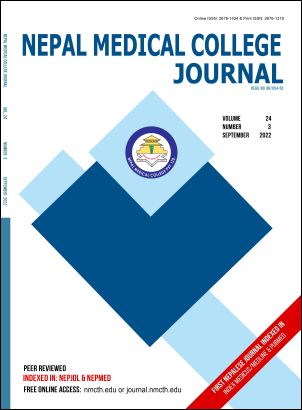Outcome of Therapeutic Penetrating Keratoplasty in R.M. Kedia Eye hospital - A Retrospective Study
DOI:
https://doi.org/10.3126/nmcj.v24i3.48591Keywords:
Therapeutic penetrating keratoplasty, infective keratitisAbstract
Infectious keratitis is the major cause of vision threatening condition and the leading cause of corneal blindness in developing countries. Therapeutic keratoplasty is the procedure for terminating or improving an actively infectious corneal disease. This study was carried out to determine the outcome of therapeutic keratoplasty for infective keratitis at R.M. Kedia eye hospital. This was retrospective study where all cases that underwent TPK for active infective keratitis from May 2019 to April 2020 were included in the study. Data were collected about demographic parameters, indication for surgery, details of donor tissue in terms of donor size, graft size and endothelial density. The outcome of TPK was measured in terms of anatomic stability, eradication of disease, graft clarity and development of cataract and glaucoma. 30 eyes of 30 patients underwent TPK for infective keratitis. 73.3% were male. Average age of the patients was 42. In 60% of patients organisms were isolated as follows: 11 cases of fungus, 3 cases of bacteria and 4 cases of mixed bacteria and fungus. Two surgeries (6.6%) were combined with extracapsular cataract extraction without posterior chamber intraocular lens. The eradication of infection after primary TPK was 23 (76.8%). Twelve eyes (40%) had documentation of variable grades of cataract. One case had secondary glaucoma. Six cases (20%) had graft failure. Therapeutic keratoplasty is the procedure for terminating or improving an actively infectious corneal disease. It helps to save the eye and preserve vision in severe infective keratitis. There is a high incidence of postoperative glaucoma, cataract, and graft failure in such a surgery.
Downloads
Downloads
Published
How to Cite
Issue
Section
License
Copyright (c) 2022 Nepal Medical College Journal

This work is licensed under a Creative Commons Attribution 4.0 International License.
This license enables reusers to distribute, remix, adapt, and build upon the material in any medium or format, so long as attribution is given to the creator. The license allows for commercial use.




